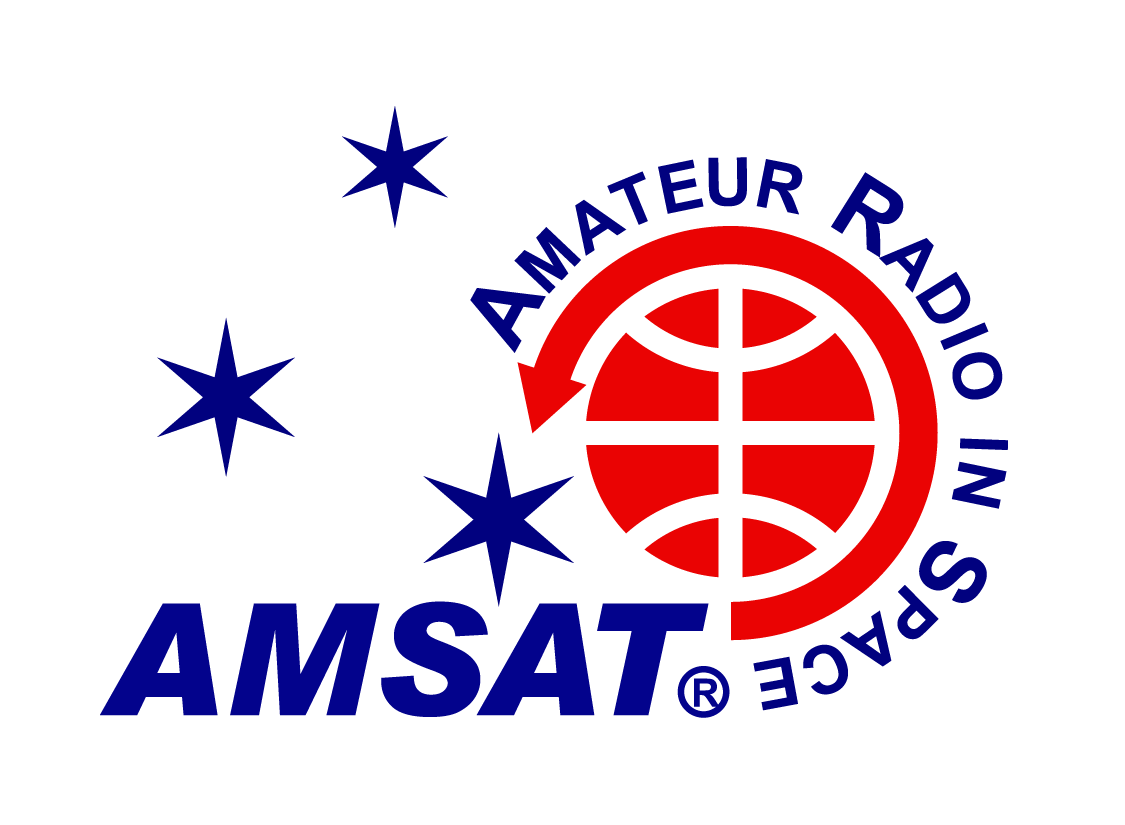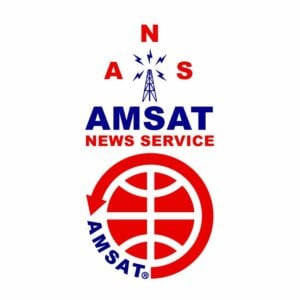
AMSAT News Service
ANS-033
February 2, 2025
In this edition:
- MO-122 – Newest OSCAR Alive and Well
- SO-120 (URESAT-1) Antennas Deployed
- Fram2Ham SSTV Simulation on ISS
- GridMasterMap Satellite Top 100 Rovers February 2025 Rankings
- Changes to AMSAT TLE Distribution for January 31, 2025
- ARISS News
- Upcoming Satellite Operations
- AMSAT Ambassador Activities
- Satellite Shorts From All Over
The AMSAT News Service bulletins are a free, weekly news and information service of AMSAT, The Radio Amateur Satellite Corporation. ANS publishes news related to Amateur Radio in Space including reports on the activities of a worldwide group of Amateur Radio operators who share an active interest in designing, building, launching and communicating through analog and digital Amateur Radio satellites.
The news feed on https://www.amsat.org publishes news of Amateur Radio in Space as soon as our volunteers can post it.
Please send any amateur satellite news or reports to: ans-editor [at] amsat.org
You can sign up for free e-mail delivery of the AMSAT News Service Bulletins via the ANS List; to join this list see: https://mailman.amsat.org/postorius/lists/ans.amsat.org/
MO-122 – Newest OSCAR Alive and Well
Mark Hammond, N8MH AMSAT Director presented a Commissioning Update at the October 2024 AMSAT Symposium. His presentation spoke about the launch of the UMaine MESAT-1 and provided operational details.
MESAT1 is now designated MESAT1-OSCAR 122 (MO-122). He explained, “Maine’s first small satellite, a 3U CubeSat, was successfully launched on July 4, 2024 from Space Launch Complex-2 at Vandenberg Space Force Base, California.
It was NASA’s Educational Launch of Nanosatellites (ELaNa) mission 43 and included eight CubeSats flying on Firefly Aerospace’s Alpha rocket.” Wikipedia provides an extensive list of ELaNa missions on its Educational Launch of Nanosatellites page.
Hammond continued, “MO-122 was designed and built at the University of Maine to use low-cost and low-power CMOS cameras to analyze water turbidity, identify urban heat islands, and predict harmful algal blooms from low Earth orbit (LEO). An AMSAT LTM-1 Module provides command/control, telemetry, and a V/u linear transponder.”
Dr. Ali Abedi, PhD, an extra class amateur KB1VJV and an active VEC, led the UMaine-Orono WiSe-Net Lab project. The UMaine student team included: Joseph Patton, Ph.D Candidate (Project Manager/Power System); Travis Russell, M.Sc Student, (Radio Engineer) and Steele Muchmore-Allen, 4+1 Graduate Student, (Flight Engineer). Scientific papers about the MESAT1 project were published including Travis Russell’s thesis.
MESAT1 has a multi-spectral (four bands in the 550-1100nm range) remote sensing instrument based on low-cost consumer-grade cameras, a custom electrical power supply, an onboard computer based on the Raspberry Pi compute module, a custom, low-cost deployable spacecraft antenna system, and a ground station with automated tracking.
Current MO-122 reception reports indicate the AMSAT / UMaine project is performing well on orbit. Here is information needed for monitoring or using MO-122:
V/u inverting linear transponder 30 kHz wide
Transponder uplink 145.910-145.940 MHz LSB
Transponder downlink 435.810-435.840 MHz USB
Telemetry downlink (Foxtelem)
435.800 MHz 1200 BPSK
Total power out 1 W
Two Line Elements (TLEs or Keplerian elements) bulletin files are updated daily in the first hour of the UTC day. The latest data for tracking MO-122 and other satellites may be found here. Also see AMSAT Telemetry Data and SatNOGs Observations and Map.
Hammond related information about his Command Station equipment. He said, “Telemetry can be routinely copied with a M2 LEO-Pack using a mast mounted low noise preamp and my Icom 9700,” suggesting that antenna orientation is very important.
Teachers, Professors and Science students may experiment with telemetry data using a low-cost receiving system consisting of a homemade J-pole antenna, Fox-In-A-Box RPi and Funcube Dongle Pro other good quality software defined radio (SDR) or device.
More details about the project are available via MaineSat.org and UMaine WiSe-Net Lab. A YouTube video by M0YKS demonstrates the Amateur Radio capabilities. Follow NASA’s Small Satellite blog for other launch updates.
In his symposium presentation Hammond acknowledged the work of the commissioning team which included; Drew Glasbrenner, KO4MA; Chris Thompson, VE2TCP/G0KLA; Burns Fisher, WB1FJ; and Paul Stoetzer, N8HM. He also thanked Eric Skoog, K1TVV for his work on the AMSAT Linear Transponder.
In addition to operating the AMSAT MO-122 Command Station, N8MH has nearly a quarter century of experience which includes operating command stations for several other AMSAT projects. A complete list of his extensively equipped Command Station can be found on his QRZ.com page.
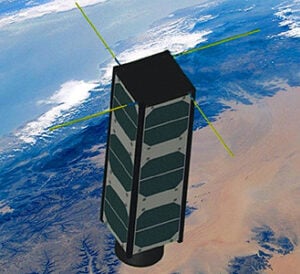
[ANS thanks AMSAT for the above information]
SO-120 (URESAT-1) Antennas Deployed
Over a year and a half after launch, SO-120 (URESAT-1) has finally deployed its antennas! Jan, PE0SAT, discovered the signal of SO-120 on January 28th and telemetry confirmed that the satellite was showing that the antennas were deployed. SO-120 was launched on June 12, 2023.
[ANS thanks Félix Páez, EA4GQS, AMSAT-EA for the above information]
Fram2Ham SSTV Simulation on ISS
Fram2 is a pioneering private astronaut mission, the first to fly astronauts over the North and South poles. Fram2 will give the four on-board astronauts unprecedented first views of the polar regions from space. While astronauts on the ISS can see a large portion of the Earth, it is not possible to see these upper regions of Earth from the ISS. Fram2 is planned to be launched no earlier than March 1, 2025 and is planning a 3 day mission with an optional 2 day extension.
The amateur radio experimental payload on Fram2, called Fram2Ham, is also pioneering in nature. It represents the first use of human spaceflight amateur (ham) radio in polar orbit and the first amateur radio transmissions from a SpaceX Dragon capsule. Fram2Ham operations are being performed by private astronaut Rabea Rogge, amateur radio callsigns LB9NJ (Norway) and KD3AID (USA).
Fram2Ham will transmit Slow Scan Television (SSTV) picture images from space to radio receivers on the ground as part of a high school and university student competition. These SSTV images can also be received by radio enthusiasts (hams, educators, and youth) worldwide and posted to the ARISS SSTV Gallery—but with a twist. Images posted will not be shown until after the Fram2 mission. These operations support the youth SSTV competition, where they are to acquire several SSTV “Puzzle Pieces,” assemble the puzzle, determine the polar location, and answer questions related to that location.
For more information on the Fram2 mission and for youth organizations interested in participating in the Fram2Ham SSTV competition, see: f2.com and Fram2Ham.com. ARISS also has a Fram2 tab on its website www.ariss.org.
The ARISS international team is planning an SSTV event to help all participating to be as proficient as possible in acquiring images from Fram2Ham and submitting them in the SSTV gallery. Like previous SSTV events, ARISS will provide special commemorative certificates for those who upload images to the gallery. Certificates will be delivered after the completion of both the Fram2 simulation event and the Fram2 mission.
SSTV Simulation details:
Hardware: ARISS radio transmitter set to low power (5 watts vs. 25 watts for previous SSTV events). This is to simulate the challenges and unknowns of a new radio system on a Dragon capsule that might be in an unfavorable attitude in some parts of the mission flight path.
Operations Frequency: 437.550 MHz. Using the SSTV (public downlink) planned for Fram2Ham, ground users can practice the more challenging 70 cm Doppler correction.
SSTV Mode: PD120. The longer image capture for this simulation (120 seconds, vs. 36 seconds for Fram2Ham’s Robot 36 SSTV mode) will allow ground users to hone their signal polarization switching skills (manually and electronically) as well as precise antenna pointing.
Operations Duration: February 13 (World Radio Day) to February 17, 2025. This long duration, over a weekend, will allow users multiple passes to practice, learn lessons, make corrections, and try again. S
Summary: There are several challenges like low transmit power, variations of antenna orientation, and a short, 3-day mission duration, with only a limited time assigned for the SSTV operation. These challenges require operating proficiency and the use of the best attainable radio station and this simulation shall give the possibility to exercise this. Are you up for the challenge?
[ANS thanks Frank Bauer, KA3HDO, ARISS International Chair, for the above information]
GridMasterMap Satellite Top 100 Rovers February 2025 Rankings
The February 2025 rankings for the Top 100 Rovers (Mixed LEO/MEO/GEO) in satellite operations, as determined by @GridMasterMap on Twitter, has been released. The ranking is determined by the number of grids and DXCC entities activated, taking into account only those grids where a minimum number of QSOs logged on the gridmaster.fr website have been validated by a third party. Grid numbers do not directly reflect the exact number of activations. Satellite operators are encouraged to upload their LoTW satellite contacts to https://gridmaster.fr in order to provide more accurate data.
Updated: 2025-01-31
| 1 | ND9M | 26 | KX9X | 51 | W7WGC | 76 | PT2AP |
| 2 | NJ7H | 27 | ON4AUC | 52 | N6DNM | 77 | LU4JVE |
| 3 | JA9KRO | 28 | KG5CCI | 53 | JK2XXK | 78 | AA8CH |
| 4 | UT1FG | 29 | N5BO | 54 | EA4NF | 79 | VE1VOX |
| 5 | N5UC | 30 | K8BL | 55 | SM3NRY | 80 | FG8OJ |
| 6 | DL6AP | 31 | KE4AL | 56 | JL3RNZ | 81 | YU0W |
| 7 | OE3SEU | 32 | KB5FHK | 57 | DF2ET | 82 | PT9BM |
| 8 | WI7P | 33 | VE3HLS | 58 | XE1ET | 83 | KJ7NDY |
| 9 | DP0POL | 34 | PA3GAN | 59 | AA5PK | 84 | KI7UXT |
| 10 | K5ZM | 35 | KI0KB | 60 | KI7QEK | 85 | N6UTC |
| 11 | F5VMJ | 36 | KI7UNJ | 61 | SP5XSD | 86 | KB2YSI |
| 12 | N6UA | 37 | LA9XGA | 62 | F4DXV | 87 | WA9JBQ |
| 13 | HA3FOK | 38 | JO2ASQ | 63 | AD7DB | 88 | N4DCW |
| 14 | WY7AA | 39 | F4BKV | 64 | VE1CWJ | 89 | JM1CAX |
| 15 | N9IP | 40 | BA1PK | 65 | KE9AJ | 90 | AF5CC |
| 16 | W5PFG | 41 | VA3VGR | 66 | DL4EA | 91 | VE3GOP |
| 17 | AK8CW | 42 | N7AGF | 67 | N8RO | 92 | N0TEL |
| 18 | DL2GRC | 43 | VK5DG | 68 | VA7LM | 93 | KG4AKV |
| 19 | AD0DX | 44 | XE3DX | 69 | M1DDD | 94 | W8MTB |
| 20 | LU5ILA | 45 | KE0WPA | 70 | KM4LAO | 95 | K0FFY |
| 21 | N4AKV | 46 | PR8KW | 71 | W8LR | 96 | CU2ZG |
| 22 | AD0HJ | 47 | K7TAB | 72 | W1AW | 97 | VE7PTN |
| 23 | WD9EWK | 48 | KE0PBR | 73 | N4UFO | 98 | K6VHF |
| 24 | ND0C | 49 | EB1AO | 74 | HB9GWJ | 99 | VE6WK |
| 25 | DJ8MS | 50 | AC0RA | 75 | BG7QIW | 100 | DK9JC |
[ANS thanks @GridMasterMap for the above information]
The 2025 AMSAT President’s Club Coins Have Just Arrived!
Celebrating the 40th Anniversary of Amateur Radio on Human Spaceflight
Help Support GOLF and Fox Plus.
Join the AMSAT President’s Club today!
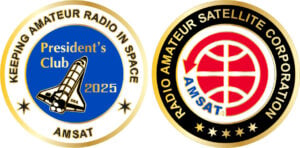
Changes to AMSAT TLE Distribution for January 31, 2025
Two Line Elements or TLEs, often referred to as Keplerian elements or keps in the amateur community, are the inputs to the SGP4 standard mathematical model of spacecraft orbits used by most amateur tracking programs. Weekly updates are completely adequate for most amateur satellites. TLE bulletin files are updated daily in the first hour of the UTC day. New bulletin files will be posted immediately after reliable elements become available for new amateur satellites. More information may be found at https://www.amsat.org/keplerian-elements-resources/.
This week there are no additions or deletions to the AMSAT TLE distribution.
[ANS thanks Joe Fitzgerald, KM1P, AMSAT Orbital Elements Manager for the above information]
Need new satellite antennas?
Purchase an M2 LEO-Pack from the AMSAT Store!
When you purchase through AMSAT, a portion of the proceeds goes towards Keeping Amateur Radio in Space.
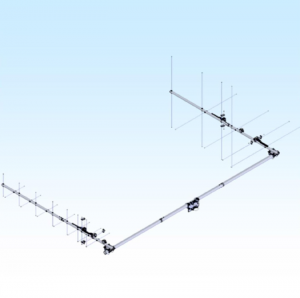
ARISS News
Amateurs and others around the world may listen in on contacts between amateurs operating in schools and allowing students to interact with astronauts and cosmonauts aboard the International Space Station. The downlink frequency on which to listen is 145.800 MHz worldwide.
Scheduled Contacts
Public Primary School, La Laupie, France, direct via F5KLF
The ISS callsign is presently scheduled to be NA1SS
The downlink frequency is presently scheduled to be 145.800 MHz
The scheduled crewmember is Don Pettit KD5MDT
The ARISS mentor is F6ICS
Contact is go for: Fri 2025-02-07 14:27:07 UTC 72 deg
Many times a school may make a last minute decision to do a Livestream or run into a last minute glitch requiring a change of the URL but we at ARISS may not get the URL in time for publication. You can always check https://live.ariss.org/ to see if a school is Livestreaming.
As always, if there is an EVA, a docking, or an undocking; the ARISS radios are turned off as part of the safety protocol.
The crossband repeater continues to be active (145.990 MHz up {PL 67} & 437.800 MHz down), If any crewmember is so inclined, all they have to do is pick up the microphone, raise the volume up, and talk on the crossband repeater. So give a listen, you just never know.
Note, all times are approximate. It is recommended that you do your own orbital prediction or start listening about 10 minutes before the listed time.
The latest information on the operation mode can be found at https://www.ariss.org/current-status-of-iss-stations.html
The latest list of frequencies in use can be found at https://www.ariss.org/contact-the-iss.html
[ANS thanks Charlie Sufana, AJ9N, one of the ARISS operation team mentors for the above information]
Upcoming Satellite Operations
A growing number of satellite rovers are currently engaged in sharing their grid square activations on https://hams.at. By visiting the website, you gain easy access to comprehensive information about the operators responsible for activating specific grid squares. Additionally, you have the ability to assess the match score between yourself and a particular rover for a given pass, while also being able to identify the upcoming satellite passes that are accessible from your location.
8R, GUYANA:
Watch out for Aldir, PY1SAD, signing 8R1TM from Georgetown between
Jan. 1 and Feb. 8. QRV on 160-10m (CW, SSB, digital modes) and via
satellites. QSL direct via homecall, LoTW, eQSL, qrz.com.
[ANS thanks Ian Parsons, K5ZM, AMSAT Rover Page Manager, JoAnne Maenpaa, K9JKM, and DXNL 2439 – January 1, 2025 DX Newsletter, for the above information]
Want to fly the colors on your own grid expedition?
Get an AMSAT car flag and other neat stuff from our Zazzle store!
25% of the purchase price of each product goes towards Keeping Amateur Radio in Space
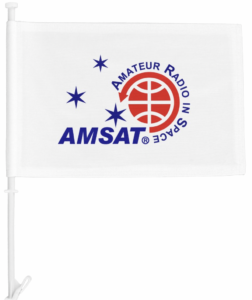
AMSAT Ambassador Activities
AMSAT Ambassadors provide presentations, demonstrate communicating through amateur satellites, and host information tables at club meetings, hamfests, conventions, maker faires, and other events.
AMSAT Ambassador Clint Bradford, K6LCS, says,
“Think a 75-minute presentation on “working the easy satellites” would be appropriate for your club or event? Let me know by emailing me at k6lcsclint (at) gmail (dot) com or calling me at 909-999-SATS (7287)!”
Clint has NEVER given the exact same show twice: EACH of the 150+ presentations so far has been customized/tailored to their audiences.
Scheduled Events
Friday, Saturday, Sunday February 7-9, 2025
Hamcation 2025 and ARRL Southeastern Division Convention
Central Florida Fairgrounds and Expo Park
4603 W. Colonial Dr.
Orlando, FL 32808
https://www.hamcation.com/
KE4AL
February 14-15, 2025
Yuma HAMCON and Southwestern Division Convention
Yuma County Fairgrounds
Yuma, AZ
https://www.yumahamfest.com/
N1UW
March 2, 2025
Midwinter Madness Hamfest
Buffalo Civic Center
1306 County Rd 134
Buffalo MN 55313
https://k0ltc.org/midwinter-madness/
KØJM, ADØHJ, KEØPBR
April 4 – 5, 2025
Southeastern VHF Conference 2025
Quality Inn
3095 Wilma Rudolph Blvd
Clarksville, TN 37040
W4FCL
[ANS thanks Bo Lowrey, W4FCL, Director – AMSAT Ambassador Program, for the above information]
Satellite Shorts from All Over
+ Mike Herr, WA6ARA, submitted a report about his activity during the W2RS Memorial AMSAT CW Activity Day, held on January 1st: “After fussing with a new tracking computer, I made one (1) CW contact, right at the end of the window. I worked WA0CTZ, Dave, at 2357 on AO-7. Fitting way to end the year and start a new one. It has rekindled my desire to operate satellites.” (ANS thanks WA6ARA for the information)
+ FO-29’s analog linear transponder will be activated at the following times in February:
February 1, 00:49~
February 2,01:38~
February 8, 01:22~
February 9, 02:12~
February 15, 01:56~
February 16, 01:00~
February 22, 00:44~
February 23, 01:34~
February 24, 00:39~
Due to FO-29’s battery status, the satellite will remain on after activation until the satellite’s undervoltage control (UVC) automatically shuts off the transponder. (ANS thanks JARL for the information)
Join AMSAT today at https://launch.amsat.org/
In addition to regular membership, AMSAT offers membership to:
- Societies (a recognized group, clubs or organization).
- Primary and secondary school students are eligible for membership at one-half the standard yearly rate.
- Post-secondary school students enrolled in at least half time status shall be eligible for the student rate for a maximum of 6 post-secondary years in this status.
- Memberships are available for annual and lifetime terms.
Contact info [at] amsat.org for additional membership information.
73 and remember to help Keep Amateur Radio in Space!
This week’s ANS Editor,
Paul Stoetzer, N8HM
n8hm [at] arrl.net
ANS is a service of AMSAT, the Radio Amateur Satellite Corporation, 712 H Street NE, Suite 1653, Washington, DC 20002
